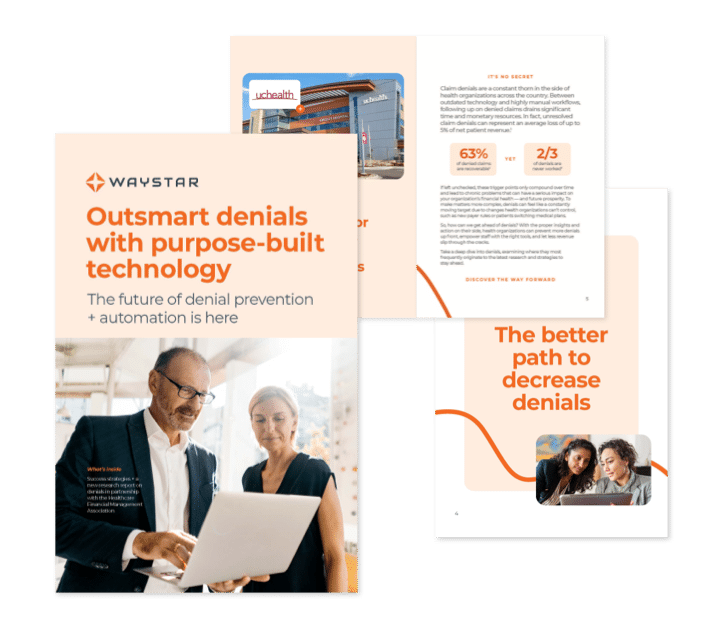Note: This post was originally published in May 2023. It was updated in August 2025.
The healthcare RCM process becomes more complex each day — and that complexity is compounded by external pressures.
“In today’s market, so many factors affect efficiency in the healthcare RCM process,” says Christine Fontaine, Waystar Solution Strategist. “Staffing issues can lead to longer time-to-payment. Ever-changing payer rules and insufficient edits can lead to staff frustration. Poor work queue routing can cause users to have to manage claims that don’t need to be reviewed.
“All of that leads to poor utilization of limited staff and a frustrating result: You keep trying to dig yourself out of a hole only to end up digging a deeper one.”
So, how do you improve your healthcare RCM process?
You start by pinpointing places where your staff is losing time and efficiency. Whether it’s taking manual touches out of statusing or using automation for prior authorization and referrals, you have to find and address your problem areas.
“I’ve worked with many organizations that, after investigating their processes, found that they’re losing productivity because staff is managing work that could easily be automated,” says Christine. “I call these unproductive touches, and I see a few over and over again.”
5 unproductive touches in healthcare RCM
CHECK YOUR HEALTHCARE RCM PROCESS FOR:
1. Insurance verification
Manually verifying eligibility adds cost and time to each transaction, which contributes to staff inefficiency. In fact, according to the 2024 CAQH Index, providers could save an estimated 12 minutes per transaction by automating eligibility — and the industry could save $11.7 billion each year by automating this and related processes.

“Despite the availability of 270 transactions, there are more than 1.5 billion calls made each year to verify eligibility and benefits,” says Christine. “Some organizations report their staff spends more than two hours per day just following up with payers! So, it’s easy to see how the industry as a whole could save billions with automation.”
Look for automated insurance eligibility technology that:
- Uses AI + RPA to identify missing coverage
- Accesses vast amounts of payer data to curate accurate benefit information
- Offers robust alerts so teams can work by exception
- Triages eligibility issues so staff can prioritize tasks properly
- Seamlessly integrates with your EHR
Explore Eligibility Verification
CHECK YOUR HEALTHCARE RCM PROCESS FOR:
2. Prior authorization + referrals
How often are staff efforts wasted on prior auths and referrals? According to the 2024 CAQH Index, the industry could save $515 million annually by automating prior authorization, and providers could save 14 minutes per transaction.
That’s an enormous amount of time to waste — especially when the frontend is getting more complex.

“Almost 80% of practices say payer requirements for prior auths increased in recent years, and that’s likely to continue,” says Christine. “Payers will keep putting in requirements to ensure care is medically necessary. And the only way for providers to stay on top of volume and reduce write-offs without adding staff is to use automated prior authorization.”
Inefficient authorization and referral processes don’t just affect staff time — they impact revenue, too. According to an HFMA denials study, healthcare finance leaders say 60% of denials come from the frontend.
Look for automated prior authorization technology that:
- Verifies, initiates, statuses, and retrieves comprehensive authorization and referral details to stop denials
- Integrates directly with your HIS and PM systems
- Streamlines authorization and referral workflows to minimize the administrative burden on staff
- Includes authorization submissions for unscheduled admissions
- Auto-generates Advance Beneficiary Notices or Notice of Non-Coverage forms
- Adapts to shifting payer rules and requirements
CHECK YOUR HEALTHCARE RCM PROCESS FOR:
3. Claim statusing
One revealing question for every RCM leader is: How much time does it take for your team to resubmit a claim or create an appeal? Manually statusing a claim takes 18 minutes longer on average.

“Retrieving actionable information from payers about claim status is very time consuming,” says Christine, “and it often results in needlessly touching claims that are already being processed properly. That takes staff away from higher value tasks, such as working problem claims.”
To address that, providers are leveraging RPA to save time and money, in addition to improving staff satisfaction.
“Automation leads to less human error, wasted efforts, re-work, and staff friction,” says Christine. “A Forbes survey found that 92% of companies saw an improvement in employee satisfaction after implementing AI and RPA. That’s because employees are more engaged and satisfied when they can focus on meaningful, useful tasks.”
Look for automated claim statusing that:
- Predicts the right time to status a claim and intelligently drives follow-up
- Facilitates rapid intervention using flexible payer connections
- Curates the most enriched status response
- Controls status checks with a scheduling capability
- Proactively monitors payer portals
CHECK YOUR HEALTHCARE RCM PROCESS FOR:
4. Denial + appeal management
Nearly 12% of claims are denied, with the cost to recover coming in at $118 per claim. Those costs are so high because manually gathering information and creating and submitting appeals takes hours upon hours each week. And that’s just one reason 80% of healthcare finance leaders say there’s room for improvement in the process of working denials.
RPA is a highly effective way to reduce denials and underpayments, especially when combined with analytics that give staff actionable information. For example, advanced solutions can help staff identify accounts with the highest likelihood of payment so they know which appeals to work first.
“Giving these professionals the tools to drive efficiency through advanced technology like machine learning and automation empowers them to perform at a higher level,” says Waystar CEO Matt Hawkins in the HFMA denials report. “The technology we can apply to healthcare payments today is incredible, and there is an increasing comfort with these tools among both seasoned and younger staff.”
Look for an automated denials + appeals solution that:
- Triages denials based on probability of payment
- Automatically routes denials to appropriate teams or work queues
- Provide real-time, one-click eligibility verification
- Offers pre-populated payer-specific forms to auto-generate appeals content for you
- Automatically submits paperless appeals packages directly to payers
Explore Denial + Appeal Management
CHECK YOUR HEALTHCARE RCM PROCESS FOR:
5. Posting + reconciliation of payments
“Manual processes around payment reconciliation are very staff intensive, not to mention error prone,” says Christine. “Manual research, follow up, and reconciliation of payments significantly increases the time associated with posting. That makes posting and reconciliation an process to automate.”
Look for a payment posting + reconciliation solution that:
- Automates matching of claims to remits
- Posts payer and patient payments
- Splits remits and identifies missing payments plus reconciliation
“There’s no doubt it’s a challenging time to be in revenue cycle management,” says Christine. “But it’s also an exciting time because there are so many opportunities to use automation to increase efficiency and help your staff engage while increasing their satisfaction.”



